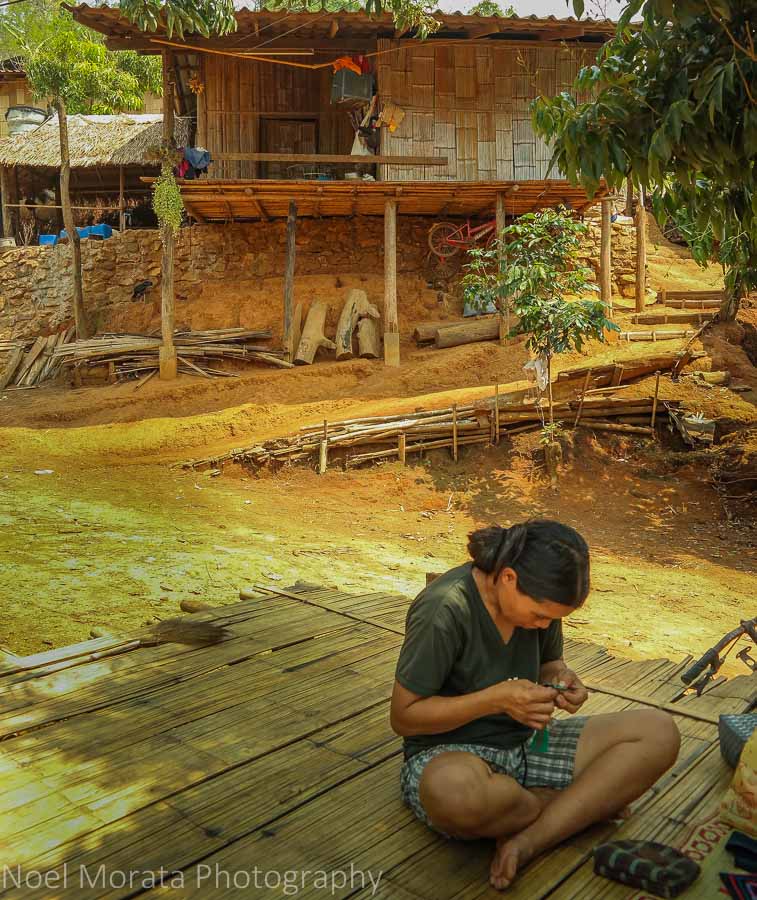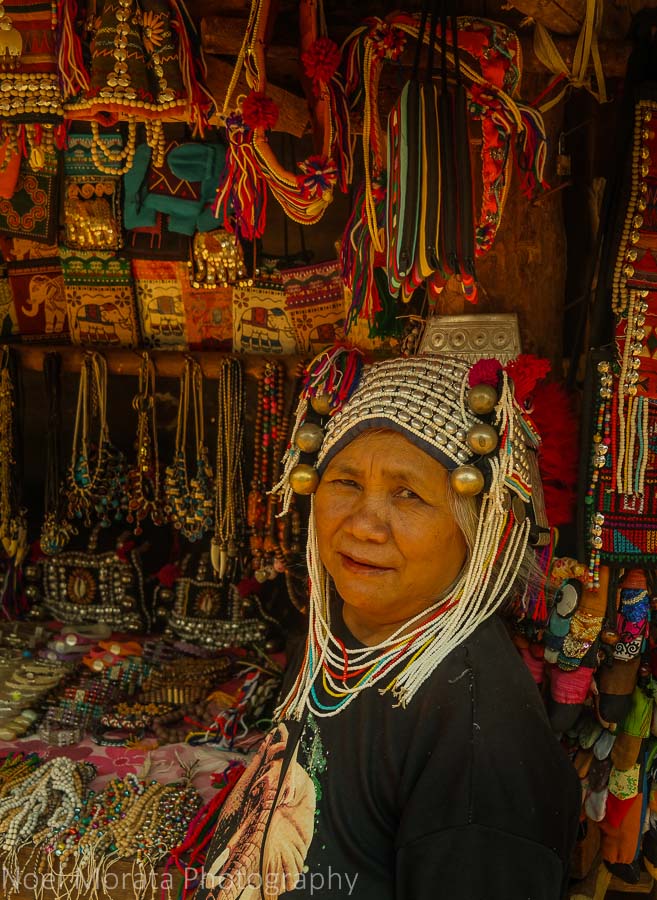The area north of the Chiang Mai province in Thailand is dotted with many hill tribes of different ethnic groups that have immigrated to this hilly area from neighboring regions. This includes the surrounding countries in Laos, China and Tibet where many of these tribes still live. OF these tribes, the most well known are the Hmong, Lisu and Akha hill tribes that have moved to Thailand. Leaving their country to avoid persecution and other civil unrest, the hill tribes have been migrating through the hilly areas of Northern Thailand and stayed to farm the fertile areas for a variety of commercial crops that are viable in the area.
While staying at the comfortable Lisu Lodge, I was able to visit both the Lisu and Akha hill tribe communities and got a chance to tour their village and meet some of the colorful tribe members that typically meet visitors. Many of the villagers spend their free time creating handicraft items they make and sell at the village for supplemental income outside of farming.
Visiting the hill tribes of Northern Thailand
The Ahka village tribe live along many of the hilly areas in the northern Chiang Mai province and live an agricultural lifestyle. We visited a tribe during the daytime without males (working at their farms), most of the villagers we met along the way were women. You see some wearing their traditional garb and head dress, many created for sale at their kiosks lining the mostly dirt road leading uphill into the more remote areas of the village.
Typical architecture and rural living with electricity
Many of the village women earn supplemental income from their craft work mostly of hand-made textile crafts they either sell at their kiosk or sell to distributors who resell them at larger regional markets or bring them down to Chiang Mai for sale in the many outdoor markets in the city. It is a very simple life and relatively easy even though the income earned from making hand-made crafts is fairly low paying, it is convenient working in any location including outdoors or while hanging out with other villagers in the streets.
Capturing some local insects for roasting
I noticed that a lot of the villagers socialize together outdoors while working on a crafting project or household function. Even though they are socializing together, they all have chores and work activities they can also do while gathering together. It is wonderful that these impromptu outdoor gatherings are a way for the community to share news or gossip while still doing everyday functions and chores.
A villager showing her handicrafts for sale
The hand-made items for sale at each stall is filled with elaborate handicrafts made by each person. Even with all the intricate details to each item, the prices are quite cheap and I can’t help but to purchase some souvenirs for gifts, even though I have no need for any of the beautiful hand-made items.
The villager below has been wearing her head dress since her husband died. She is an elder who was married to the village shaman (medicine man) and is comfortable with her traditional lifestyle and costume. Even though her children have moved to the modern city of Chiang Mai and adopted more modern lifestyles far away from this rural area, she maintains a very simple life and home. Many of the children in the village eventually move away from the village, preferring a more urban city environment than working hard in an agricultural capacity that is monotonous and low paying.
We visit the widowers simple bamboo home to see the interior and her rustic kitchen below, and she prepares some hot tea for her visitors in this simple hearth on the ground. It is amazing to see that this type of lifestyle is still being maintained but also quickly diminishing from this village. I admire the few collections and organic materials that make up this mostly bamboo and wood framed home with lots of open air peeking in between the wood slats of the home.
I also visited the Lisu tribe while staying at the Lisu Lodge which is a wonderful eco resort an hours drive from Chiang Mai. The village is located just outside the resort and again was empty of the men who were doing their farming during the day time. Most of the villagers that we met were older women who were also busy working on the sewing machines and creating pillows, purses and other textile crafts for sale at the tourist markets in Chiang Mai or just locally. A few of the villagers where also recruited to work at the resort in different capacities including the Thai masseur lady below who gave an excellent body massage on the lanai (deck patio) of each villa at the resort. It was fantastic that Lisu Lodge and their owners Asian Oasis really help to hire and train the younger villagers to work at the resort instead of the typical exodus to the larger city of Chiang Mai where most hope to get better employment. I just wrote about my eco stay at Lisu lodge, you can check out this wonderful stay and the eco practices Lisu Lodge promotes here.
You can also check out these cool lodges and places to stay in Northern Thailand here for updated reviews and prices.
If you enjoyed this post, please check these Northern Thailand must see attractions
15 top places to visit in Northern Thailand
Thailand travel – 10 tips and suggestions
Untapped Loei in Northern Thailand
A Loatian village in Northern Thailand
Hill tribe stay in Northern Thailand
Thanks for reading my post on the Hill tribes of Northern Thailand for Travel Photo Mondays. Please do visit some of the bloggers participating below for today’s link up. While visiting the Lisu and Akha hill tribes, I was a guest at the Lisu Lodge, all opinions and thoughts are my own. If you want to take some of their village tribe tours or stay at their eco lodge at Lisu Lodge, you can find out more details on this website here.
If you like what you see, come and check out my other social media channels for more updates, including Instagram, Pinterest and Twitter
Disclosure – There are affiliates links on this posts which provide a small commission to support this site at no extra cost to you. Thank you for reading, and happy travels














Wonderful pictures of everyday life! Thanks for sharing!
Beautiful village and amazing photos – so vibrant and colorful. Those insects though … I can’t imagine eating them.
I loved reading about different tribes and the pictures are beautiful 🙂
Noel: Wow – Amazing as always. Your photos tell such a wonderful story of a beautiful group of people, that I will never meet. How do they feel about having their picture taken?
I usually watch them and try to engage, point to my camera and nod to see if they are okay with having a photo picked.
I’m really glad to get a look at these villages through your eyes since I didn’t have a chance to visit a real village, only one of those multi-tribe Cultural Village Centers, when I was in Chiang Mai. I think I’d be buying up those handicrafts, too, as they are so lovely. I like that you had a chance to chat with some of the villagers and find out their story instead of just snapping a photo and moving on.
I was in that area a little over 10 years ago. At that time some of the villages were inhabited by people who had been exiled from Burma/Myanmar and were not allowed to become Thai citizens. They lived in a restricted sort of no-man’s land. Do you happen to know if that the case with any of the people you visited? You have some wonderful photos!
Great souvenirs….
Fantastic photos. What a wonderful experience for you. I appreciate being able to see your photos and read about your adventure!
Nice images. I made a memorable visit to Northern Thailand a few years ago. The people dress so colorfully. My regret is that I didn’t buy more of their crafts when I had the chance.
Noel, I am so glad you and your camera visited the hill people. As always, your photos tell the story—-and artfully. The photo with the large red shade umbrella is very artful.
I’m used to seeing your beautiful landscapes but these portraits of people are even more compelling! Beautiful photography~
Beautiful captures of the local people. Incredible size of those insects… did you try them?
I only tried a few bbq, not so appetizing and crunchy as expected Rossana
Thanks for this look at the Lisu and Akha hill tribe communities. It was fascinating and your photos are gorgeous. I found it interesting that there are experiencing similar situations with youth as rural agricultural communities in North America – the youth moving to urban environments in order to make a living and have an easier life.
Hi Noel – I just came across your blog on Triberr. Such beautiful photos 🙂 I’ll be sure to check out more of your posts
I loved your portraits of the older ladies and their head gear. Faces tell quite a story.
Beautiful photos, as always. Nice to meet some of the people. Interesting stories. Interesting hat the widow wears.
Amazing photos, as always, Noel. Looks like an amazing and memorable adventure.
I really like seeing the details in your photos: the handicrafts and adornments, the concentration in the masseuse’s face and the mass of bugs awaiting their demise! This glimpse of life in the hills is inspiring.
Several years ago when we lived in Missoula, MT I remember meeting several Hmong refugees and seeing their impressive intricate handwork and the vivid colors of their embroidery. Your photos of the Hill Tribes people are beautiful and I also loved the picture with the bright orange parasol as well as your opening photo of the thatched roof home and countryside.
Hey! I found you this week! 🙂 I’m enjoying your Hill Tribe posts – this looks a lot like the village we visited. (It’s the same ethnic group.) I struggle with what to think about the changes these villages are facing – I can’t blame the young people for wanting to move to the city where they can have a more modern life, but there has to be a middle ground where traditions can be preserved as part of a modern lifestyle. It sounds like the resort you stayed at is trying to help make that happen. I hope they succeed and that others follow their model.